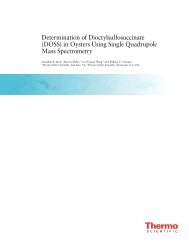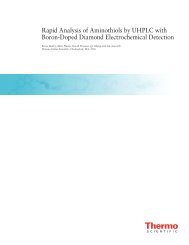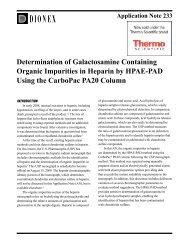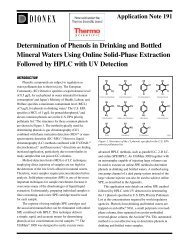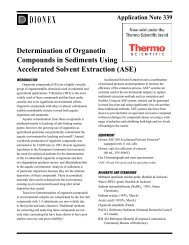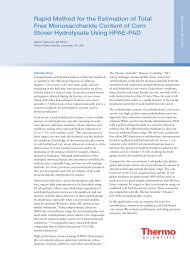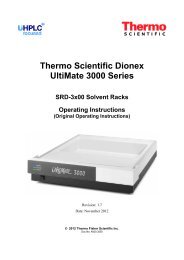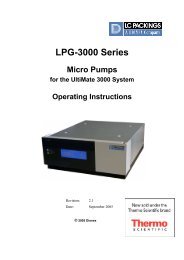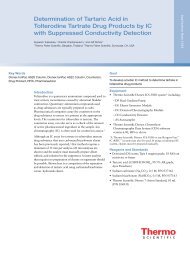IonPac AS9-SC and AS9-HC Anion-Exchange Columns ... - Dionex
IonPac AS9-SC and AS9-HC Anion-Exchange Columns ... - Dionex
IonPac AS9-SC and AS9-HC Anion-Exchange Columns ... - Dionex
Create successful ePaper yourself
Turn your PDF publications into a flip-book with our unique Google optimized e-Paper software.
columns<br />
The <strong>IonPac</strong> <strong>AS9</strong>-<strong>SC</strong> (solvent<br />
compatible) is a carbonate-selective<br />
anion-exchange column designed for the<br />
fast, isocratic separation of inorganic<br />
anions <strong>and</strong> oxyhalides including<br />
fluoride, chlorite, bromate, chloride,<br />
nitrite, bromide, chlorate, nitrate,<br />
phosphate, <strong>and</strong> sulfate in drinking water,<br />
groundwater, wastewater, <strong>and</strong> other<br />
diverse sample matrices. The <strong>IonPac</strong><br />
<strong>AS9</strong>-<strong>HC</strong> is a high-capacity anionexchange<br />
column with selectivity<br />
similar to the <strong>AS9</strong>-<strong>SC</strong> column. The<br />
<strong>AS9</strong>-<strong>HC</strong> column is also designed for the<br />
analysis of inorganic anions <strong>and</strong><br />
oxyhalides but has higher capacity <strong>and</strong><br />
provides improved separation for trace<br />
bromate in drinking water matrices<br />
using an isocratic carbonate eluent <strong>and</strong> a<br />
large loop injection. The high capacity<br />
<strong>AS9</strong>-<strong>HC</strong> column also offers improved<br />
retention of fluoride out of the water dip.<br />
<strong>IonPac</strong> ® <strong>AS9</strong>-<strong>SC</strong> <strong>and</strong> <strong>AS9</strong>-<strong>HC</strong><br />
<strong>Anion</strong>-<strong>Exchange</strong> <strong>Columns</strong><br />
<strong>IonPac</strong> <strong>AS9</strong>-<strong>SC</strong> Features<br />
The <strong>IonPac</strong> <strong>AS9</strong>-<strong>SC</strong> has a unique<br />
selectivity, permitting the fast, isocratic<br />
separation of fluoride, chlorite, bromate,<br />
chloride, nitrite, bromide, nitrate,<br />
phosphate, <strong>and</strong> sulfate in less than<br />
10 minutes using a bicarbonate/carbonate<br />
eluent coupled with suppressed<br />
conductivity detection as illustrated in<br />
Figure 1A. The <strong>IonPac</strong> <strong>AS9</strong>-<strong>SC</strong> is<br />
specified in validated methods such as<br />
U.S. EPA Method 300.0 (B).<br />
<strong>IonPac</strong> <strong>AS9</strong>-<strong>HC</strong> Features<br />
The <strong>IonPac</strong> <strong>AS9</strong>-<strong>HC</strong> column<br />
provides improved separation of the<br />
common inorganic anions <strong>and</strong> the<br />
oxyhalides over the <strong>AS9</strong>-<strong>SC</strong> as illustrated<br />
in Figure 1B. Increased retention<br />
time on the <strong>AS9</strong>-<strong>HC</strong> (approximately<br />
22 minutes) is due to the high capacity<br />
(190 µeq for 4 x 250 mm) of the column.<br />
High capacity allows for the determination<br />
of trace bromate in drinking water<br />
using a large loop injection <strong>and</strong> an<br />
isocratic carbonate eluent. The <strong>AS9</strong>-<strong>HC</strong><br />
also provides improved separation of<br />
bromate/chloride, chloride/nitrite, <strong>and</strong><br />
chlorate/nitrate analyte pairs. The <strong>AS9</strong>-<br />
<strong>HC</strong> column is specified in validated<br />
methods such as U.S. EPA Method 300.1.
High Efficiency Particle Structure<br />
The <strong>IonPac</strong> <strong>AS9</strong>-<strong>SC</strong> <strong>and</strong> <strong>AS9</strong>-<strong>HC</strong><br />
column packings have unique structures<br />
composed of a highly crosslinked core<br />
<strong>and</strong> a MicroBead anion exchange<br />
layer attached to the surface, as shown<br />
in Figures 2 <strong>and</strong> 3. The substrate for the<br />
<strong>IonPac</strong> <strong>AS9</strong>-<strong>SC</strong> is a 13-µm diameter<br />
microporous resin bead <strong>and</strong> the<br />
<strong>AS9</strong>-<strong>HC</strong> column substrate is a 9-µm<br />
diameter macroporous resin bead, both<br />
consisting of ethylvinylbenzene<br />
crosslinked with 55% divinylbenzene.<br />
The anion exchange layer is<br />
functionalized with quaternary ammonium<br />
groups. This anion exchange<br />
layer has a controlled thickness, which<br />
results in excellent mass transfer<br />
characteristics <strong>and</strong> consequently, very<br />
high efficiency peaks.<br />
Economical Microbore Operation<br />
The <strong>IonPac</strong> <strong>AS9</strong>-<strong>SC</strong> <strong>and</strong> <strong>AS9</strong>-<strong>HC</strong><br />
columns are available in the 2-mm format<br />
for microbore operation to offer the<br />
advantage of reduced operating costs.<br />
• Ideal for limited sample volumes<br />
due to higher mass sensitivity.<br />
• Three- to fourfold reduction in<br />
eluent consumption.<br />
• 4-mm applications can be performed<br />
using the 2-mm format<br />
reducing flow rate by fourfold.<br />
Solvent Compatible Packing<br />
Because the <strong>IonPac</strong> <strong>AS9</strong>-<strong>SC</strong> <strong>and</strong><br />
<strong>AS9</strong>-<strong>HC</strong> columns are 100% HPLC<br />
solvent compatible, organic solvents<br />
can be used for efficient column cleanup<br />
or to enhance sample solubility. The<br />
elimination of time-consuming sample<br />
preparation saves time <strong>and</strong> expense <strong>and</strong><br />
extends the utility of the column to new<br />
applications requiring solvents. Adding<br />
organic solvents to the eluent modifies<br />
column selectivity <strong>and</strong> enables the<br />
elution of nonpolar analytes or contaminants<br />
from the column.<br />
Column A: <strong>IonPac</strong> AG9-<strong>SC</strong>, <strong>AS9</strong>-<strong>SC</strong>, 4 mm<br />
Column B: <strong>IonPac</strong> AG9-<strong>HC</strong>, <strong>AS9</strong>-<strong>HC</strong>, 4 mm<br />
Eluent A:<br />
Eluent B:<br />
1.8 mM Sodium carbonate<br />
1.7 mM Sodium bicarbonate<br />
9 mM Sodium carbonate<br />
Flow Rate A: 2.0 mL/min<br />
Flow Rate B: 1.0 mL/min<br />
Inj. Volume A: 50 µL<br />
Inj. Volume B: 25 µL<br />
Detection: Suppressed conductivity, ASRS ® ,<br />
AutoSuppression ® 2<br />
5<br />
7<br />
6<br />
1<br />
4<br />
3<br />
recycle mode<br />
A B<br />
Peaks: 1. Fluoride<br />
2. Chlorite<br />
1<br />
5<br />
3<br />
10<br />
mg/L (ppm)<br />
3. Bromate<br />
4. Chloride<br />
5<br />
1.5<br />
20<br />
6<br />
5. Nitrite<br />
6. Bromide<br />
7. Chlorate<br />
8. Nitrate<br />
6<br />
10<br />
15<br />
15<br />
15<br />
25<br />
25<br />
25<br />
9. Phosphate 20 40<br />
10. Sulfate 25 30<br />
8<br />
A<br />
15<br />
10<br />
µS<br />
9<br />
0<br />
0 1 2 3 4 5 6 7 8 9<br />
B<br />
8<br />
1<br />
4<br />
2<br />
3<br />
5<br />
6 8<br />
10<br />
µS<br />
7<br />
9<br />
0<br />
0 5 10 15 20 25<br />
Minutes<br />
Figure 1. Comparison of the <strong>AS9</strong>-<strong>SC</strong> <strong>and</strong> <strong>AS9</strong>-<strong>HC</strong> columns for the separation of inorganic<br />
anions <strong>and</strong> oxyhalides.<br />
Ethylvinylbenzene-<br />
Divinylbenzene Core<br />
6.5 µm<br />
Figure 2. Structure of an <strong>IonPac</strong> <strong>AS9</strong>-<strong>SC</strong> packing particle.<br />
Ethylvinylbenzene-<br />
Divinylbenzene Core<br />
Figure 3. Structure of an <strong>IonPac</strong> <strong>AS9</strong>-<strong>HC</strong> packing particle.<br />
Highly Crosslinked Core<br />
110-nm Diameter<br />
MicroBeads<br />
<strong>Anion</strong> <strong>Exchange</strong><br />
Latex Coating<br />
<strong>Anion</strong> <strong>Exchange</strong><br />
Latex Coating<br />
Highly<br />
Crosslinked<br />
Core<br />
90-nm Diameter<br />
MicroBeads<br />
12966<br />
12901<br />
12902
Determination of Trace Bromate in<br />
Drinking Water Matrices<br />
Bromate, a disinfection byproduct<br />
of the ozonation disinfection process for<br />
drinking water, has been cited by the U.S.<br />
EPA <strong>and</strong> the World Health Organization<br />
as a potential carcinogen, even at low<br />
µg/L (ppb) concentrations.<br />
A simple, isocratic method has<br />
been developed using the high capacity<br />
<strong>IonPac</strong> <strong>AS9</strong>-<strong>HC</strong> column to determine<br />
bromate at low µg/L concentrations.<br />
This method uses a large loop injection<br />
with an isocratic carbonate eluent<br />
coupled with suppressed conductivity<br />
detection as illustrated in Figure 4.<br />
Sample Pretreatment<br />
For drinking water samples<br />
containing excessive chloride concentrations,<br />
an OnGuard ® Ag cartridge can<br />
be used to remove the chloride followed<br />
by an OnGuard H to remove<br />
residual silver ions. The OnGuard H<br />
also removes carbonate. Figure 5<br />
illustrates the use of this pretreatment.<br />
<strong>Columns</strong>: <strong>IonPac</strong> AG9-<strong>HC</strong>, <strong>AS9</strong>-<strong>HC</strong>, 4 mm<br />
A Simulated Drinking Water<br />
Eluent: 9.0 mM Sodium carbonate<br />
1 4 5 8 10<br />
Flow Rate: 1.0 mL/min<br />
0.2<br />
Inj. Volume: 200 µL<br />
Detection: Suppressed conductivity, ASRS,<br />
AutoSuppression external water mode<br />
Peaks: A B<br />
µS<br />
1. Fluoride 1.0 0.04 mg/L (ppm)<br />
9<br />
2. Chlorite 0.01 —<br />
2<br />
3<br />
6 7<br />
3. Bromate<br />
4. Chloride<br />
0.005 —<br />
50.0 16.2<br />
0<br />
5. Nitrite 0.1 —<br />
6. Bromide 0.01 0.03<br />
0 5 10 15 20 25<br />
7. Chlorate 0.01 0.04<br />
8. Nitrate 10.0 3.9<br />
B Sunnyvale Drinking Water<br />
4<br />
0.5<br />
1<br />
8<br />
10<br />
9. o-Phosphate 0.1<br />
10. Sulfate 50.0<br />
0.15<br />
18.3<br />
µS<br />
0<br />
6 7 9<br />
0 5 10 15 20 25<br />
Minutes<br />
Figure 4. Determination of trace bromate in drinking water using the <strong>AS9</strong>-<strong>HC</strong> column.<br />
0.5<br />
A Without OnGuard Pretreatment<br />
µS<br />
0<br />
0.5<br />
µS<br />
0<br />
1<br />
2 3<br />
4<br />
5<br />
0 5 10 15 20 25<br />
B With OnGuard-Ag <strong>and</strong> OnGuard-H Pretreatment<br />
1 2<br />
3<br />
4<br />
5<br />
0 5 10 15 20 25<br />
Minutes<br />
6<br />
6<br />
7<br />
7<br />
8<br />
8<br />
9<br />
9<br />
<strong>Columns</strong>: <strong>IonPac</strong> AG9-<strong>HC</strong>, <strong>AS9</strong>-<strong>HC</strong>, 4 mm<br />
Eluent: 9.0 mM Sodium carbonate<br />
Flow Rate: 1.0 mL/min<br />
Inj. Volume: 500 µL<br />
Detection: Suppressed conductivity, ASRS,<br />
AutoSuppression external water mode<br />
Peaks: 1. Fluoride 0.02 mg/L (ppm)<br />
2. Unknown —<br />
3. Bromate 0.01<br />
4. Chloride 240.0<br />
5. Nitrite 0.002<br />
6. Chlorate 0.04<br />
7. Nitrate 0.3<br />
8. o-Phosphate 0.1<br />
9. Sulfate 10.0<br />
Figure 5. Effect of OnGuard pretreatment on drinking water samples with excessive chloride<br />
concentrations.<br />
12967<br />
12951
<strong>AS9</strong>-<strong>SC</strong> Fast Run for Chloride <strong>and</strong><br />
Sulfate<br />
Sulfur <strong>and</strong> chlorine play important<br />
roles in many catalytic processes<br />
used for petrochemical production.<br />
With combustion-IC, the total sulfur<br />
<strong>and</strong> chlorine contents of polymeric<br />
catalysts can be determined with high<br />
accuracy <strong>and</strong> precision. The <strong>AS9</strong>-<strong>SC</strong><br />
provides a rapid method to determine<br />
chloride <strong>and</strong> sulfate in polymeric<br />
catalysts. With an optimized carbonate<br />
eluent, these analytes can be determined<br />
in less than 8 minutes, as<br />
illustrated in Figure 6.<br />
<strong>AS9</strong>-<strong>HC</strong> for Inorganic <strong>Anion</strong>s in<br />
Solvents<br />
Monitoring anionic contaminants<br />
in the manufacture of semiconductor<br />
materials such as organic solvents is<br />
important because yield <strong>and</strong> reliability<br />
can be significantly compromised by<br />
ionic contamination. An isocratic<br />
method has been developed using the<br />
high-capacity <strong>AS9</strong>-<strong>HC</strong> column to<br />
determine trace anions in watermiscible<br />
organic solvents. Figure 7<br />
illustrates the separation of trace anions<br />
in semiconductor isopropyl alcohol. For<br />
more details on this application please<br />
refer to <strong>Dionex</strong> Application Note 85.<br />
60<br />
µS<br />
0<br />
1<br />
2<br />
3<br />
Column: <strong>IonPac</strong> AG9-<strong>SC</strong>, <strong>AS9</strong>-<strong>SC</strong>, 4 mm<br />
Eluent: 3 mM Sodium carbonate<br />
Flow Rate: 2 mL/min<br />
Inj. Volume: 50 µL<br />
Detection: Suppressed conductivity, ASRS,<br />
AutoSuppression recycle mode<br />
Peaks: 1. Chloride<br />
2. Nitrate<br />
3. Sulfate<br />
Concentrations (n=3):<br />
Chlorine, 10.9% ± 0.01%<br />
Sulfur, 4.9% ± 0.01%<br />
ISO calibration data unavailable.<br />
Figure 6. Determination of chloride <strong>and</strong> sulfate in a polymeric catalyst using the <strong>AS9</strong>-<strong>SC</strong><br />
column.<br />
1<br />
µS<br />
0<br />
0 2 4<br />
Minutes<br />
6<br />
8<br />
<strong>Columns</strong>: <strong>IonPac</strong> AG9-<strong>HC</strong>, <strong>AS9</strong>-<strong>HC</strong>, 2 mm<br />
Eluent: 8.0 mM Sodium carbonate<br />
1.5 mM Sodium hydroxide<br />
Flow Rate: 0.25 mL/min<br />
Sample Volume: 5.0 mL<br />
Detector: Suppressed conductivity, ASRS,<br />
AutoSuppression external water mode<br />
Peaks: 1. Unidentified — µg/L (ppb)<br />
2. Chloride 1.67<br />
3. Carbonate —<br />
4. Unidentified —<br />
5. Nitrate 1.98<br />
6. Sulfate 2.74<br />
0 5 10 15<br />
Minutes<br />
20 25<br />
30<br />
7. Phosphate 1.11<br />
1<br />
2<br />
3<br />
5 6<br />
4 7<br />
Figure 7. Trace anion analysis of spiked semiconductor isopropyl alcohol using the <strong>AS9</strong>-<strong>HC</strong><br />
column.<br />
12975<br />
14819
<strong>AS9</strong>-<strong>HC</strong> for High Ionic Strength<br />
Samples<br />
The high capacity <strong>AS9</strong>-<strong>HC</strong> column<br />
is ideal for difficult applications such as<br />
trace nitrite in complex matrices, including<br />
meat <strong>and</strong> milk products, fertilizers, soil<br />
extracts, <strong>and</strong> wastewater. Figure 8A<br />
illustrates the analysis of 0.2 ppm nitrite<br />
spiked into ASTM synthetic wastewater<br />
containing 2000 ppm chloride. Using an<br />
isocratic carbonate eluent <strong>and</strong> suppressed<br />
conductivity detection, a 10,000:1 ratio of<br />
chloride/nitrite can be analyzed with the<br />
<strong>AS9</strong>-<strong>HC</strong> column.<br />
UV detection at 214 nm provides<br />
improved sensitivity for nitrite <strong>and</strong> allows<br />
ratios up to 111,000:1 of chloride/nitrite to<br />
be analyzed as illustrated in Figure 8B.<br />
Chloride, which is UV transparent, is seen<br />
as a large dip at 7 minutes, <strong>and</strong> does not<br />
interfere with the quantification of nitrite.<br />
A<br />
3<br />
µS<br />
0<br />
B<br />
0.04<br />
AU<br />
0<br />
Column: <strong>IonPac</strong> ® 3<br />
8<br />
Eluent:<br />
AG9-<strong>HC</strong>, <strong>AS9</strong>-<strong>HC</strong>, 4 mm<br />
9.0 mM Sodium carbonate<br />
Flow Rate: 1.0 mL/min<br />
1<br />
7<br />
Inj. Volume: 25 µL<br />
Detection A: Suppressed conductivity,<br />
ASRS, AutoSuppression recycle mode<br />
2 4<br />
5<br />
6<br />
Detection B: UV at 214 nm<br />
A B<br />
Peaks: 1. Fluoride 1.14 — mg/L (ppm)<br />
2. Acetate — —<br />
0 5 10 15 20 25<br />
3.<br />
4.<br />
Chloride —<br />
Nitrite 0.14<br />
—<br />
0.18<br />
5. Bromide 0.82 0.79<br />
6. Nitrate 1.47 1.58<br />
7. Phosphate 21.1 —<br />
8. Sulfate 30.3 —<br />
6<br />
Sample: Synthetic wastewater<br />
containing 2000 mg/L chloride<br />
4<br />
5<br />
0 5 10 15 20 25<br />
Minutes<br />
Figure 8. Comparison of suppressed conductivity detection <strong>and</strong> UV detection for the<br />
determination of trace nitrite in a wastewater sample containing high levels of chloride.<br />
<strong>IonPac</strong> <strong>AS9</strong>-<strong>SC</strong> Column<br />
Dimensions:<br />
<strong>IonPac</strong> <strong>AS9</strong>-<strong>SC</strong> Analytical Column:<br />
4 x 250 mm<br />
<strong>IonPac</strong> AG9-<strong>SC</strong> Guard Column:<br />
4 x 50 mm<br />
Maximum Operating Pressure:<br />
4000 psi<br />
Mobile Phase Compatibility:<br />
pH 2–11; 0–100% HPLC solvents<br />
Substrate Characteristics:<br />
Bead Diameter: 13.0 µm<br />
Crosslinking (%DVB): 55%<br />
Latex Characteristics:<br />
Functional Group: Alkyl quaternary<br />
ammonium ion<br />
Latex Crosslinking: 20%<br />
Latex Diameter: 110 nm<br />
Hydrophobicity: Medium<br />
Capacity:<br />
30–35 µeq (4 x 250 mm column)<br />
Column Construction:<br />
PEEK with 10–32 threaded ferrulestyle<br />
end fittings. All components are<br />
nonmetallic.<br />
SPECIFICATIONS<br />
14928<br />
<strong>IonPac</strong> <strong>AS9</strong>-<strong>HC</strong> Column<br />
Dimensions:<br />
<strong>IonPac</strong> <strong>AS9</strong>-<strong>HC</strong> Analytical Column:<br />
2 x 250 mm <strong>and</strong> 4 x 250 mm<br />
<strong>IonPac</strong> AG9-<strong>HC</strong> Guard Column:<br />
2 x 50 mm <strong>and</strong> 4 x 50 mm<br />
Maximum Operating Pressure:<br />
4000 psi<br />
Mobile Phase Compatibility:<br />
pH 0–12; 0–100% HPLC solvents<br />
Substrate Characteristics:<br />
Bead Diameter: 9.0 µm<br />
Pore Size: 2000 Å<br />
Crosslinking (%DVB): 55%<br />
Latex Characteristics:<br />
Functional Group: Alkyl/alkanol<br />
quaternary ammonium ion<br />
Latex Crosslinking: 15%<br />
Latex Diameter: 90 nm<br />
Hydrophobicity: Medium-Low<br />
Capacity:<br />
47.5 µeq (2 x 250 mm column)<br />
190 µeq (4 x 250 mm column)<br />
Column Construction:<br />
PEEK with 10–32 threaded ferrulestyle<br />
end fittings. All components are<br />
nonmetallic.
Ordering Information<br />
For optimum ease-of-use <strong>and</strong><br />
economy, the <strong>IonPac</strong> <strong>AS9</strong>-<strong>SC</strong> <strong>and</strong><br />
<strong>AS9</strong>-<strong>HC</strong> columns should be used with<br />
the <strong>Anion</strong> Self-Regenerating Suppressor<br />
® . For added ease-of-use, <strong>Dionex</strong><br />
offers <strong>AS9</strong>-<strong>SC</strong> <strong>and</strong> <strong>AS9</strong>-<strong>HC</strong> Eluent<br />
Concentrates <strong>and</strong> a line of anion<br />
st<strong>and</strong>ards to make your chromatography<br />
analysis even easier. See the part<br />
numbers listed or refer to the <strong>Dionex</strong><br />
Product Selection Guide for more<br />
details.<br />
When performing sodium<br />
tetraborate gradient anion exchange<br />
applications on the <strong>AS9</strong>-<strong>SC</strong> <strong>and</strong><br />
<strong>AS9</strong>-<strong>HC</strong>, an <strong>Anion</strong> Trap Column (ATC)<br />
should be installed between the<br />
gradient pump <strong>and</strong> the injection valve<br />
to remove anionic contaminants from<br />
the eluent.<br />
For 4-mm concentrator work, use<br />
the appropriate guard (<strong>IonPac</strong> AG9-<strong>SC</strong><br />
or AG9-<strong>HC</strong>), TAC Concentrator<br />
column, or the AMC-1 <strong>Anion</strong><br />
MicroConcentrator when a single<br />
piston pump such as the DQP or DXP<br />
is used for sample delivery. Use the<br />
TAC-LP1 Concentrator column when<br />
the sample is delivered with a syringe<br />
or with an autosampler such as the<br />
AS40 or AS50.<br />
For 2-mm concentrator work, use<br />
the appropriate guard (<strong>IonPac</strong> AG9-<strong>SC</strong><br />
or AG9-<strong>HC</strong>) or the AMC-1 <strong>Anion</strong><br />
MicroConcentrator when a single<br />
piston pump such as the DQP or DXP<br />
is used for sample delivery.<br />
ORDERING INFORMATION<br />
In the U.S., call 1-800-346-6390 or contact the <strong>Dionex</strong> regional office nearest<br />
you. Outside the U.S., order through your local <strong>Dionex</strong> office or distributor.<br />
Refer to the following part numbers.<br />
Description Part Number<br />
<strong>IonPac</strong> <strong>AS9</strong> <strong>Columns</strong><br />
<strong>IonPac</strong> <strong>AS9</strong>-<strong>SC</strong> Analytical Column<br />
(4 x 250 mm) .......................................................................................... 043185<br />
<strong>IonPac</strong> AG9-<strong>SC</strong> Guard Column<br />
(4 x 50 mm) ............................................................................................ 043186<br />
<strong>IonPac</strong> <strong>AS9</strong>-<strong>HC</strong> Analytical Column<br />
(4 x 250 mm) .......................................................................................... 057186<br />
<strong>IonPac</strong> AG9-<strong>HC</strong> Guard Column<br />
(4 x 50 mm) ............................................................................................ 051791<br />
<strong>IonPac</strong> <strong>AS9</strong>-<strong>HC</strong> Analytical Column<br />
(2 x 50 mm) ............................................................................................ 052244<br />
<strong>IonPac</strong> AG9-<strong>HC</strong> Guard Column<br />
(2 x 50 mm) ............................................................................................ 052248<br />
Trap <strong>Columns</strong><br />
ATC-1 <strong>Anion</strong> Trap Column<br />
(for use with 4-mm columns) ................................................................ 037151<br />
ATC (2-mm) <strong>Anion</strong> Trap Column<br />
(for use with 3-mm columns) ................................................................ 043131<br />
Concentrator <strong>Columns</strong><br />
TAC-2 Trace <strong>Anion</strong> Concentrator<br />
(3 x 35 mm) ............................................................................................ 043101<br />
TAC-LP1 Trace <strong>Anion</strong> Concentrator<br />
(4 x 35 mm) ............................................................................................ 046026<br />
AMC-1 <strong>Anion</strong> MicroConcentrator<br />
(2 x 15 mm) ............................................................................................ 051760<br />
Eluent Concentrates<br />
Sodium Carbonate/Bicarbonate Concentrate<br />
(500 mL of 100X concentrate. For use with <strong>AS9</strong>-<strong>SC</strong> column) ............. 039513<br />
0.5 M Carbonate <strong>Anion</strong> Eluent Concentrate<br />
(500 mL of 100X concentrate. For use with <strong>AS9</strong>-<strong>HC</strong> column) ............ 037162<br />
OnGuard, ASRS, AutoSuppression, <strong>Anion</strong> Self-Regenerating Suppressor,<br />
<strong>and</strong> <strong>IonPac</strong> are registered trademarks <strong>and</strong> MicroBead<br />
is a trademark of <strong>Dionex</strong> Corporation.<br />
Printed on recycled <strong>and</strong> recyclable paper<br />
<strong>Dionex</strong> Corporation <strong>Dionex</strong> Corporation <strong>Dionex</strong> U.S. Regional Offices <strong>Dionex</strong> International Subsidiaries<br />
1228 Titan Way Salt Lake City Technical Center Sunnyvale, CA (408) 737-8522 Austria (01) 616 51 25 Belgium (015) 203800 Canada (905) 844-9650 China (852) 2428-3282 Denmark (45) 36 36 90 90 France 01 39 46 08 40<br />
P.O. Box 3603 1515 West 2200 South, Suite A Westmont, IL (630) 789-3660 Germany 06126-991-0 Italy (06) 66 51 50 52 Japan (06) 6885-1213 The Netherl<strong>and</strong>s (0161) 43 43 03 Switzerl<strong>and</strong> (062) 205 99 66<br />
Sunnyvale, CA Salt Lake City, UT Houston, TX (281) 847-5652 United Kingdom (01276) 691722<br />
94088-3603 84119-1484 Atlanta, GA (770) 432-8100 * Designed, developed, <strong>and</strong> manufactured under an NSAI registered ISO 9001 Quality System.<br />
(408) 737-0700 (801) 972-9292 Marlton, NJ (609) 596-0600<br />
LPN 0912-02 4M 1/01<br />
©2001 <strong>Dionex</strong> Corporation




